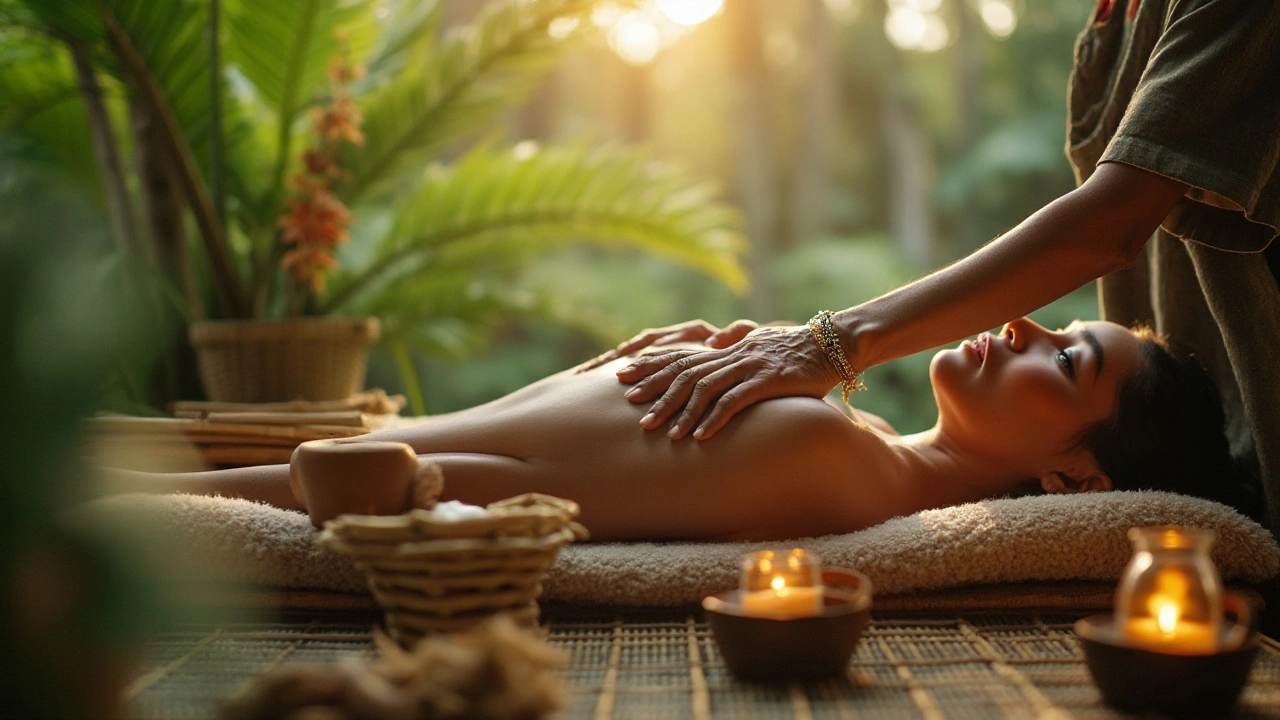Unlocking Benefits: The Power of Touch in Hilot Therapy
 Aug, 18 2024
Aug, 18 2024
In the hustle and bustle of modern life, finding a moment of tranquility can be challenging. That's where Hilot therapy comes in. This traditional Filipino healing art harnesses the power of touch to restore balance and promote well-being.
Dating back centuries, Hilot is more than just a massage. It involves a holistic approach to health, addressing not only physical discomfort but also emotional and spiritual imbalances. With techniques rooted in indigenous knowledge, each session is a unique experience tailored to the individual's needs.
Whether you're looking to relieve stress, ease chronic pain, or simply enjoy a rejuvenating break, Hilot therapy offers a comprehensive solution. Discover how this ancient practice can be a game-changer for your health and wellness.
- What is Hilot Therapy?
- The Origin of Hilot
- Techniques Used in Hilot
- Health Benefits of Hilot
- Finding a Certified Practitioner
- Incorporating Hilot into Your Routine
What is Hilot Therapy?
Hilot therapy, a traditional healing practice from the Philippines, is much more than a simple massage. It seamlessly blends physical touch with the healing wisdom passed down through generations. Known for its hands-on approach, Hilot focuses on detecting and correcting imbalances in the body. Practitioners of Hilot, often referred to as manghihilot, use their hands intuitively to locate tension and stress points, aiming to return the body to its natural state of harmony.
The origins of Hilot are deeply entrenched in Filipino culture. For centuries, this practice has been used to address a variety of ailments, from muscle pain to internal disorders. What sets Hilot apart from other massage therapies is its holistic nature. Instead of just treating symptoms, Hilot seeks to uncover the underlying causes of discomfort, whether they are physical, emotional, or spiritual in nature. This comprehensive approach makes it an effective method for achieving long-term wellness.
A typical Hilot session involves techniques such as kneading, pressure application, and stretching. These methods are not random; they are chosen based on the individual’s specific needs. Before starting the session, a manghihilot may conduct a brief assessment to understand the person's condition better. They look at overall energy flow, muscle stiffness, and even emotional state to tailor the treatment effectively. Hilot therapy is thus highly personalized, making each session unique.
The use of natural elements also plays a crucial role in Hilot. Coconut oil, banana leaves, and herbal concoctions are frequently used as part of the treatment. Coconut oil, revered for its anti-inflammatory properties, helps ease muscle soreness and promotes skin health. Banana leaves, on the other hand, are believed to draw out negative energy from the body. These natural elements add another layer of therapeutic benefits, enhancing the overall effectiveness of Hilot.
According to Dr. Bibiano F. “Boy” Fajardo, a well-known advocate of Hilot, “Hilot is the Filipino way of easing the burden of living, of maintaining balance in our lives.”
It’s more than just physical relief; it’s a way to harmonize the body, mind, and spirit.This philosophy is integral to understanding Hilot’s enduring appeal. As it gains recognition worldwide, more people are discovering its potential to restore health holistically.
Many modern practices and spas have started to include Hilot therapy in their wellness programs. Its effectiveness in reducing stress, alleviating pain, and enhancing overall well-being has made it popular among those seeking alternative treatments. As awareness continues to grow, Hilot is poised to become a staple in holistic health care, both in the Philippines and beyond.
The Origin of Hilot
The story of Hilot therapy reaches back through the centuries, deep into the rich fabric of Filipino culture. Unlike modern massage practices, Hilot is intertwined with the daily life and traditions of indigenous Filipinos. It is an ancient art passed down through generations, usually within families, making it a deeply personal and communal practice. Hilot isn't merely a technique but an embodiment of cultural knowledge and holistic healing philosophy.
This traditional practice is centered on the concept of 'harmony' within the body. Ancient Filipino healers, known as “manghihilot,” believed that ailments stem from an imbalance within the body’s energy flow. These healers used their hands to feel energy disturbances and address them accordingly. They utilized indigenous plants, oils, and natural elements during the therapy, further rooting the practice in nature and heritage.
Historical records suggest that Hilot dates back to pre-colonial times when early Filipinos thrived without the influence of Western medicine. The skills and knowledge of manghihilot were highly respected, and their role was crucial in maintaining the health and well-being of their communities. Healing through touch was seen as a gift, often regarded as a calling rather than a profession.
The enduring popularity of Hilot can be attributed to its adaptability and effectiveness. While the core principles remain unchanged, the methods have evolved to incorporate new findings and techniques. The practice has also attracted interest from the global wellness community, further solidifying its place as a valuable and versatile form of Filipino wellness.
"Hilot is much more than a massage; it’s a practice deeply rooted in Filipino heritage, embodying a holistic approach to health that integrates body, mind, and spirit." - Dr. Jaime Galvez Tan, Filipino health expert.
The cultural significance of Hilot is also evident in community rituals and celebrations. During special occasions or in times of crisis, the manghihilot would perform rituals to cleanse and protect the community from negative energies. These rituals often included chanting, prayer, and the use of sacred herbs, highlighting the spiritual dimension of Hilot.
In recent years, efforts have been made to revive and preserve this traditional art. Workshops, certification programs, and collaborations with health organizations are helping to spread the knowledge and practice of Hilot both locally and internationally. It’s a way to honor the wisdom of ancestors while providing a valuable resource for modern-day health and wellness.

Techniques Used in Hilot
Hilot therapy is a rich tapestry of methods rooted in Filipino culture and healing traditions. Each session is highly personalized, focusing on the unique needs and conditions of the individual. One of the cornerstones of Hilot is its diagnostic phase, known as "Tumbal." During this phase, a practitioner uses their hands to identify areas of imbalance or blockage in the body. This tactile diagnosis allows the healer to understand where to direct the therapeutic focus, ensuring that the treatment is as effective as possible.
Another key technique is "Lunas," which involves the actual therapeutic manipulation of muscles and tissues. The healer uses a variety of strokes, from kneading and pressing to tapping and squeezing. These are not random movements but are thoughtfully applied to facilitate the flow of energy or "katawan" in the body. The goal is to break down blockages and restore harmony, enabling the body to heal itself efficiently.
Herbal treatment is often incorporated into Hilot sessions. Practitioners use freshly made poultices, liniments, or infused oils derived from native plants like oregano, ginger, and coconut. These herbal remedies are believed to enhance the therapeutic effects, reducing inflammation and promoting deeper relaxation. A vital part of the healing process involves applying these botanical preparations to specific points on the body to amplify the massage's benefits.
Heat therapy is another integral part of Hilot. Heated banana leaves or bamboo sticks are sometimes used to enhance muscle relaxation and improve circulation. The heat helps to loosen tight muscles, making them more receptive to manual manipulation. This combination of heat and touch can be particularly effective for those suffering from chronic conditions or severe muscle tightness.
Breathing techniques and meditation play a subtle yet significant role in Hilot therapy. Practitioners often guide clients through deep breathing exercises, aiming to align the breath with the rhythm of the massage strokes. This not only helps in relaxing the body but also fosters a meditative state that can enhance overall well-being. Deep, rhythmic breathing makes the client more attuned to their body, facilitating a more profound healing experience.
Interestingly, some Hilot practices incorporate elements of bone setting, known as "Hilot Hilis" or "Lunas Tik-tik." In these cases, the healer manipulates the bones or joints to treat musculoskeletal issues like dislocations or misalignments. These techniques require a high skill level and in-depth knowledge of human anatomy, making it essential to seek a qualified practitioner for such treatments.
In essence, Hilot therapy is a holistic healing practice that combines various techniques to promote physical, emotional, and spiritual well-being. It's not just about relieving pain but also about finding balance and harmony within oneself. As a traditional method deeply ingrained in Filipino culture, Hilot offers a unique approach to wellness that modern therapies often overlook.
Health Benefits of Hilot
The health benefits of Hilot therapy go well beyond simple relaxation. This ancient healing art addresses a wide range of physical and emotional issues. One of the primary benefits is its ability to alleviate chronic pain. By using targeted pressure and specific techniques, Hilot can ease muscle stiffness and improve joint mobility, making it an effective treatment for conditions like arthritis and sciatica.
Another significant advantage is its capacity to reduce stress and anxiety levels. The gentle and rhythmic strokes used in Hilot help activate the parasympathetic nervous system, promoting a state of deep relaxation. This can be particularly beneficial for individuals suffering from high-stress jobs or anxiety disorders. Scientific studies have shown that physical touch can increase the production of oxytocin, often referred to as the 'love hormone,' which plays a crucial role in social bonding and stress reduction.
The holistic nature of Hilot therapy also means it supports emotional well-being. Practitioners often incorporate elements of traditional Filipino spirituality and healing rituals, creating a balanced approach that nurtures the mind and spirit. This makes Hilot a go-to therapy for those dealing with emotional distress or trauma. According to the Philippine Institute of Traditional and Alternative Health Care, Hilot is recognized as a valuable complementary medicine therapy.
In addition to its mental and emotional benefits, Hilot can also improve overall physical health. Regular sessions can boost the immune system, enhance blood circulation, and improve skin health. These benefits are achieved through manipulations that stimulate the lymphatic system, helping to detoxify the body. This makes Hilot not only a therapy for those with specific ailments but also a preventative measure for maintaining general health.
Women, in particular, may find Hilot beneficial. The therapy is known to help with menstrual pain and hormonal imbalances. Special techniques can be employed to address reproductive health, making it a holistic option for women experiencing issues like irregular periods or menopause symptoms. Olivia, my spouse, discovered Hilot during a trip to Manila and found it immensely helpful for her cramps and stress.
Hilot therapy can also enhance digestive health. By applying pressure on specific points in the abdomen, therapists can help improve digestion and alleviate problems like constipation and bloating. Many people report feeling lighter and more energized after a session, attributing it to the detoxifying effects of the treatment.

Finding a Certified Practitioner
Choosing the right professional for your Hilot therapy is crucial. The effectiveness of this traditional Filipino healing art largely depends on the practitioner's skill and knowledge of specific techniques. So, how do you find a certified practitioner who meets these criteria?
First, it's important to know that in the Philippines, Hilot practitioners are often certified by institutions dedicated to preserving and teaching traditional medicine. Some of these include the Hilot Academy of Binabaylan and the Technical Education and Skills Development Authority (TESDA). These organizations ensure that practitioners undergo extensive training in various Hilot techniques, making them well-equipped to provide authentic and effective treatments.
Manuel Ravago, a renowned Hilot expert, once said, "A true Hilot healer doesn't just massage your body; they connect with your energy to understand and address its needs."When looking for a practitioner outside the Philippines, you might face a bit of a challenge. However, many countries now have Filipino wellness centers and practitioners trained in Hilot therapy. Begin your search by visiting local wellness centers, spas, and holistic health clinics. It's essential to inquire about the practitioner's training background and certifications to ensure you receive genuine Hilot therapy.
Another valuable tip is to seek recommendations from friends or community groups dedicated to health and wellness. Personal testimonials can be extremely useful when evaluating the credibility of a Hilot practitioner. Additionally, online forums and social media groups can provide you with detailed reviews and experiences from previous clients.
For those who prefer a more structured approach, there are several online directories and resources where certified Hilot practitioners are listed. Websites like the Global Therapeutic Healing Association (GTHA) offer a comprehensive list of professionals who have met strict certification standards. These directories typically provide information on the practitioner's background, areas of specialization, and contact details.
When you find a potential practitioner, don't hesitate to set up a consultation before committing to a session. During this meeting, discuss your health concerns and goals for the therapy. An experienced practitioner will take the time to understand your needs, explain how Hilot can benefit you, and tailor the treatment accordingly.
Lastly, keep in mind that the benefits of Hilot therapy are rooted in the practitioner's understanding of your unique energy and imbalances. Trust your instincts when choosing a practitioner. If you feel a genuine connection and sense of trust, it's likely you've found the right healer for your journey to wellness.
Incorporating Hilot into Your Routine
Adding Hilot therapy into your regular wellness regimen can be a transformative experience. The practice not only rejuvenates your body but also provides a holistic approach to mental and emotional health. To start, it’s essential to understand how often you should engage in these sessions. Many experts recommend beginning with weekly visits. This frequency helps your body adjust and maximizes the benefits of the therapeutic touch.
Once you’ve gained familiarity, bi-weekly or even monthly sessions may be sufficient. The key is listening to your body and recognizing its needs. For those living with chronic pain, more frequent sessions might be necessary. Consult with your **certified Hilot practitioner** to tailor a schedule that accommodates your unique needs.
Relaxation techniques are crucial in Hilot therapy. These may include breathing exercises or meditation practices that set the tone for your session. Integrating these techniques into your daily routine can make your visits more effective. Rituals like starting your day with a few minutes of deep breathing or a brief meditation can enrich your overall experience with Hilot.
Creating a Serene Home Environment
Transforming a part of your home into a relaxation zone can keep the benefits of Hilot alive between sessions. While a complete home spa might be ideal, even a small, peaceful nook will do. Adorn this space with calming elements like candles, essential oils, and soft music. Incorporating **aromatherapy** can significantly enhance your mental and emotional well-being.
According to Dr. Maria Villanueva, a well-known expert in traditional Filipino healing methods, 'The environment you create at home can extend and magnify the healing effects of Hilot therapy.' This advice underscores the importance of your living space in supporting your wellness journey.Diet also plays a critical role. Consuming balanced meals rich in vitamins and minerals can complement the benefits of Hilot. Fresh fruits, vegetables, lean proteins, and whole grains should be staples in your diet. Hydration is another key factor. Ensuring you drink plenty of water daily aids in flushing out toxins, keeping your body in top shape.
Combining Modern and Traditional Practices
While Hilot offers numerous benefits, combining this ancient technique with modern wellness practices can yield even greater results. Regular exercise, be it yoga, pilates, or even a daily walk, can work hand in hand with Hilot to enhance your body’s flexibility and strength. Physical activities promote circulation and muscle relaxation, making it easier for your practitioner to work on releasing tension points during your sessions.
- Consider scheduling your Hilot sessions after your workout. This can alleviate muscle soreness and accelerate recovery.
- Maintain a journal to track the changes you observe. This helps in communicating your specific needs with your therapist effectively.
- Don’t neglect sleep. Good quality sleep is essential for the healing process and maintaining overall health.
Lastly, be patient with yourself. Introducing a new wellness practice like Hilot into your routine involves an adjustment period. Trust the process and remain committed. Over time, you’ll likely observe not only physical improvements but also a more balanced and serene state of mind.
